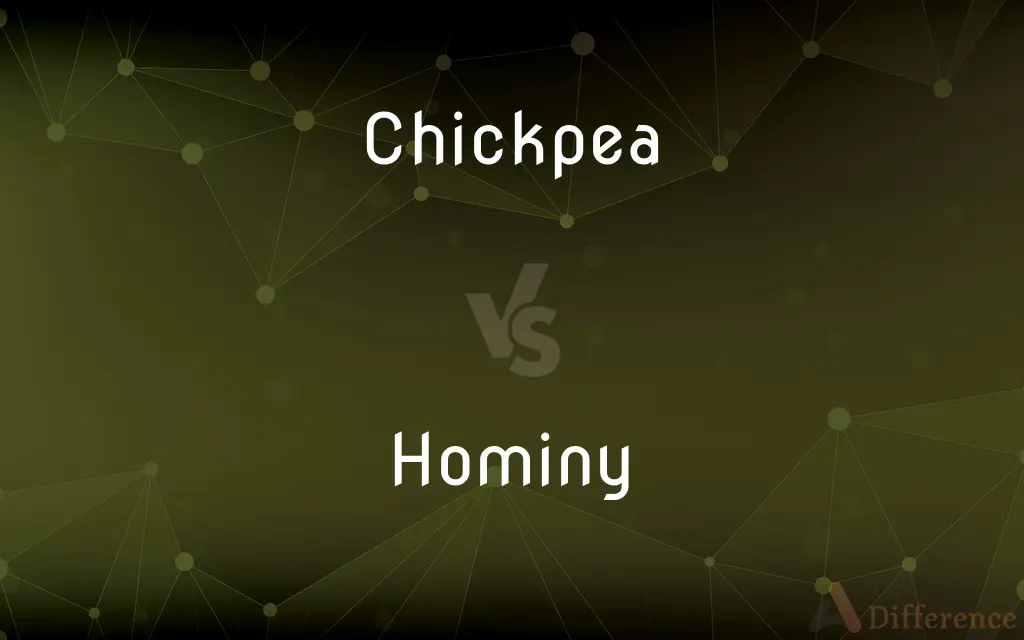Chickpea vs. Hominy — What's the Difference?
Edited by Tayyaba Rehman — By Urooj Arif — Updated on March 20, 2024
Chickpeas are legumes known for their versatility in dishes like hummus, while hominy is dried corn soaked in an alkali solution, often used in Mexican cuisine.

Difference Between Chickpea and Hominy
Table of Contents
ADVERTISEMENT
Key Differences
Chickpeas, also known as garbanzo beans, are a type of legume that comes in several varieties, including the most common beige color, as well as black, green, and red. They are a staple in many diets around the world, famous for their use in dishes like hummus and chana masala. Hominy, on the other hand, is made from dried maize kernels that have been treated with an alkali in a process called nixtamalization. This process not only alters the kernel's structure, making it softer and easier to grind but also enhances its nutritional value by making niacin more available and improving protein quality.
Nutritionally, chickpeas are a rich source of protein, dietary fiber, vitamins, and minerals, making them a popular choice for vegetarians and vegans seeking protein-rich food options. Hominy also offers nutritional benefits, including a decent amount of dietary fiber, vitamin B, and minerals. However, the nixtamalization process that hominy undergoes increases its calcium content, setting it apart from chickpeas.
In culinary applications, chickpeas are incredibly versatile; they can be used whole in salads, soups, and stews, ground into flour, or mashed and mixed into various dishes. Hominy's use in cuisine is distinct, often found in Mexican and Southern United States dishes such as pozole (a traditional soup or stew) or ground into masa for making tortillas and tamales.
From a preparation standpoint, chickpeas require soaking before cooking to reduce cooking time and improve digestibility. Hominy, sold canned or dried, is already soaked as part of its processing and can be used directly from the can or cooked further if purchased dried.
Comparison Chart
Origin
Legume (bean family)
Dried corn treated with alkali
ADVERTISEMENT
Nutritional Value
High in protein, fiber, vitamins, minerals
Rich in dietary fiber, vitamin B, calcium (from processing)
Culinary Uses
Salads, soups, hummus, flour
Pozole, masa for tortillas, grits
Preparation
Requires soaking before cooking
Pre-soaked, ready to use from can or requires cooking if dried
Cultural Significance
Middle Eastern, Indian cuisine
Mexican, Southern US cuisine
Compare with Definitions
Chickpea
A small, round, beige legume used in various dishes worldwide.
She added chickpeas to her salad for extra protein.
Hominy
Used to make masa for corn tortillas and tamales.
She ground soaked hominy to prepare masa for her homemade tortillas.
Chickpea
Can be ground into flour known as gram or besan.
Chickpea flour is a gluten-free alternative for baking.
Hominy
Can be eaten whole, ground, or as grits.
For breakfast, he enjoyed a bowl of hominy grits with cheese.
Chickpea
Rich in nutrients like protein and fiber.
Chickpeas are a great addition to a vegetarian diet due to their high protein content.
Hominy
Offers a unique texture and flavor to dishes.
The chef used hominy to add a special texture to his stew.
Chickpea
The main ingredient in hummus.
He blended chickpeas with tahini to make a creamy hummus.
Hominy
Rich in calcium due to the nixtamalization process.
Hominy is a good source of calcium, thanks to its preparation process.
Chickpea
Available in canned or dried forms.
I prefer using dried chickpeas for my recipes after soaking them overnight.
Hominy
Dried maize kernels treated with an alkali process.
Hominy is a key ingredient in traditional Mexican pozole.
Chickpea
The chickpea or chick pea (Cicer arietinum) is an annual legume of the family Fabaceae, subfamily Faboideae. Its different types are variously known as gram or Bengal gram, garbanzo or garbanzo bean, or Egyptian pea.
Hominy
Hominy is a food produced from dried maize (corn) kernels that have been treated with an alkali, in a process called nixtamalization (nextamalli is the Nahuatl word for "hominy"). "Lye hominy" is a type of hominy made with lye.
Chickpea
An annual Asian plant (Cicer arietinum) in the pea family, widely cultivated for the edible seeds in its short inflated pods.
Hominy
Coarsely ground corn (maize) used to make grits
Hominy grits
Chickpea
A seed of this plant. In both senses also called garbanzo.
Hominy
Whole or ground kernels of corn from which the hull and germ have been removed, as by boiling in a solution of water and lye.
Chickpea
An annual Asian plant (Cicer arietinum) in the pea family, widely cultivated for the edible seeds in its short inflated pods.
Hominy
A food made from hulled corn (maize) kernels soaked in lye water, rinsed, then cooked and eaten; or, the rinsed kernels are dried and coarsely ground into hominy grits.
Chickpea
A seed of this plant, often used as a food.
Chickpea is valued for its nutritive seeds with high protein content.
Hominy
Maize hulled and broken, and prepared for food by being boiled in water.
Chickpea
The seed of the chickpea plant
Hominy
Hulled corn with the bran and germ removed
Chickpea
Asiatic herb cultivated for its short pods with one or two edible seeds
Chickpea
Large white roundish Asiatic legume; usually dried
Common Curiosities
What are the health benefits of chickpeas?
Chickpeas offer health benefits including high protein and fiber content, which can aid in digestion, weight management, and supporting muscle health.
Can chickpeas and hominy be used interchangeably in recipes?
Due to their different textures and flavors, chickpeas and hominy are not typically interchangeable in recipes.
How does the nixtamalization process affect hominy?
Nixtamalization improves hominy's nutritional value by increasing calcium content, enhancing protein quality, and making niacin more available.
Can you make flour out of hominy like chickpea flour?
While hominy can be ground into masa, it is not typically made into a flour for general baking purposes like chickpea flour.
Are chickpeas gluten-free?
Yes, chickpeas are naturally gluten-free, making them a popular ingredient in gluten-free diets.
What is the main difference between chickpeas and hominy?
Chickpeas are legumes rich in protein and fiber, while hominy is processed corn, high in calcium, used distinctively in Mexican cuisine.
Is hominy considered a grain or a vegetable?
Hominy is considered a grain since it is made from dried maize kernels.
How long do you need to soak chickpeas before cooking?
Chickpeas should be soaked for 8-12 hours or overnight before cooking to reduce cooking time and improve digestibility.
How do you store cooked chickpeas and hominy?
Both cooked chickpeas and hominy should be stored in an airtight container in the refrigerator and consumed within a few days.
What are some popular dishes made with hominy?
Popular dishes include pozole in Mexican cuisine and hominy grits in Southern US cuisine.
Do chickpeas have any allergenic potential?
Like all legumes, chickpeas can cause allergic reactions in some people, though they are not among the most common allergens.
Can hominy be eaten without further cooking when bought canned?
Yes, canned hominy is precooked and can be eaten without further cooking, though it is often heated or cooked further in recipes.
Is canned hominy as nutritious as dried hominy?
Canned hominy retains most of the nutritional benefits of dried hominy, although fresh foods may have a slight nutritional edge.
What is the environmental impact of growing chickpeas compared to corn for hominy?
Chickpeas have a relatively low environmental impact, requiring less water than many crops. Corn, depending on the farming practices, can have a higher environmental footprint.
Can chickpeas help with weight loss?
Yes, the high fiber and protein content in chickpeas can help promote feelings of fullness, aiding in weight management.
Share Your Discovery

Previous Comparison
Abandoned vs. Forlorn
Next Comparison
Comfort vs. PleasureAuthor Spotlight
Written by
Urooj ArifUrooj is a skilled content writer at Ask Difference, known for her exceptional ability to simplify complex topics into engaging and informative content. With a passion for research and a flair for clear, concise writing, she consistently delivers articles that resonate with our diverse audience.
Edited by
Tayyaba RehmanTayyaba Rehman is a distinguished writer, currently serving as a primary contributor to askdifference.com. As a researcher in semantics and etymology, Tayyaba's passion for the complexity of languages and their distinctions has found a perfect home on the platform. Tayyaba delves into the intricacies of language, distinguishing between commonly confused words and phrases, thereby providing clarity for readers worldwide.















































